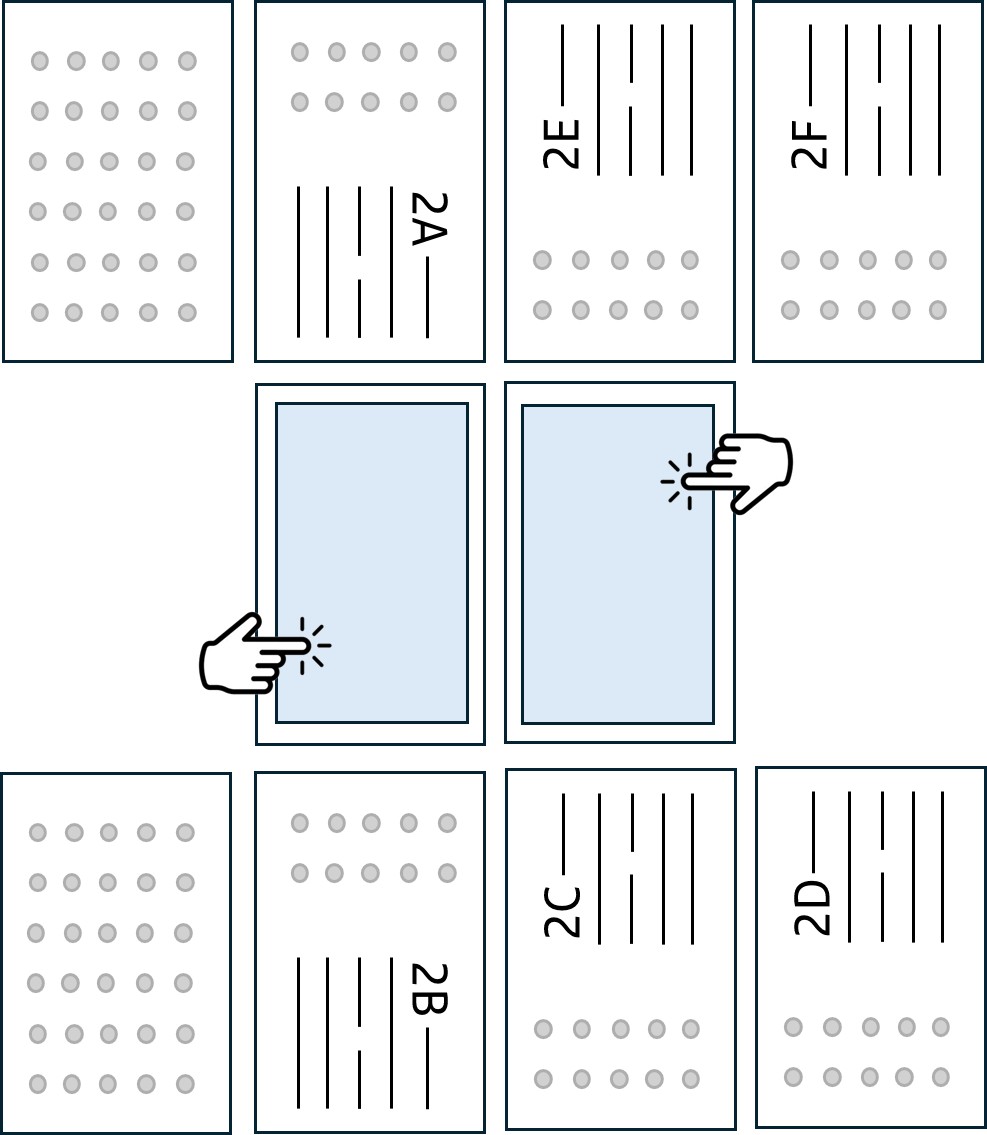
2A. Religious message on coins
Islamic coins typically had a strong religious content and a total absence of images or devices, as the representation of figures was prohibited. Instead, coins, whether gold or silver, bore inscriptions such as ‘God is one’ or ‘Muhammad is the Prophet’, as well as the date in letters and the name of the corresponding emir or caliph. These coins, made from very thin planchets, circulated for centuries throughout the Iberian Peninsula, with gold dinars or doubloons being particularly popular.
Their influence was so profound that Christian monarch began to imitate them as the Reconquista advanced. Alfonso VIII
(1174-1214) issued the first gold maravedis, which featured his initials, ALF, on the obverse and replaced the Islamic messages with Christian proclamations, such as ‘Prince of the Catholics’ and invocations to God and the Holy Spirit.
Coins thus served as a vehicle for religious propaganda: from the Islamic style with Qur’anic texts to the portraits, heraldry, crosses and Christian messages that would come later.
International currency
The florin was a coin of great international prestige that originated in Florence in 1252. Its design, stamped with the fleur-de-lis on the obverse and the image of John the Baptist on the reverse, was imitated by various European kingdoms, without featuring the monarch’s name, an exception in the European numismatic tradition.
In the Middle Ages, the right to mint coins was a symbol of power, and kings often included their name and image as a form of propaganda. The florin broke with this trend, acting as a common currency between different states.
Peter IV of Aragon, recognising its prestige and international standing, decided to issue it at the Perpignan mint in 1346. Although he stuck to the original design, he added his title ARAGO REX (King of Aragon) and the king’s initial next to the fleur-de-lis as a hallmark of his authority.
Gold coins were not common in Aragon, Catalonia or Valencia, so the guilder’s issue was strongly symbolic: Peter IV aimed to position himself as the equal of the great European monarchs through a currency with global standing.
2B. Segovia Royal Mint
One of the main concerns in coin minting was to prevent clipping of the metal, which was more difficult in perfectly round coins. To solve this problem, Archduke Ferdinand gave his cousin, Philip II, a set of roller mills from the Hall mint (in the Tyrol) which were capable of minting circular coins. After years of planning, the machines arrived in Segovia in 1585 and were installed to harness the power of the Eresma River. In 1586 the first minting trials began at the Royal Mint, considered one of the most advanced mints of its time and the sole and direct property of the king. Segovia was the only city with two active mints: the so-called Casa Vieja (hammer mint) and the new Ingenio or Royal Mint.
The mechanical process used engraved rollers and hydraulic power to stamp the metal, after which the perfectly rounded coins were punched out. Coins minted in this way are among the most brilliant in worldwide numismatics, and included the famous cincuentines and centenes (50 reales and 100 escudos), large and ostentatious coins minted for kings and wealthy nobles. These coins were the first Spanish coins to show a date, value and mintmark: the Segovia aqueduct.
2C. Coin of the two hemispheres or Spanish Dollar
During the second reign of Philip V, key monetary policy reforms were implemented: types of coin were unified, the weights and quality standards of the metal were regulated, and the mints were placed under the control of the Royal Treasury.
Although Segovia had the cutting-edge Royal Mint, it was not feasible to implement this technology in all mints. The biggest problems persisted, namely counterfeit coins and, above all, the severing or clipping of the metal. To combat this, measures were introduced such as round coinage and the decorative border motif or cordoncillo, an engraving on the edge that revealed manipulation.
On 9 June 1728, an order restricted minting on the mainland to coins of 8 and 4 reales, while in the Indies the issue of smaller denominations was also authorised. This gave rise to the type of coin known as the ‘two hemispheres’ or Spanish Dollar (columnario in Spanish), regulated by the Pragmatica of 8 September 1728, and featuring two mottos: Plus Ultra (further beyond) and Utraque Unum (one kingdom under one king). These coins became a symbol of Spain’s global power and were widely accepted. The first mint to adopt this type of coin was that of Mexico in 1732. In 1772 Charles III put an end to the Spanish Dollar and introduced a new reordering. During its forty years of existence, the Spanish Dollar cemented the place of Spanish silver as the foremost international coin, widely and abundantly used across several continents, and it was an essential pillar for the new sterling silver duro, featuring the bust, to strengthen the prestige of Spanish silver.
2D. Proclamation and swearing-in medals
Although money has an obvious role as a means of payment, it can also be a vehicle for propaganda and to spread messages. It was in this context that medals first emerged: they were pieces minted using techniques similar to coins, but generally without an economic purpose, and although some of them matched the weight and grade of the metal and came to circulate as money, their main purpose was commemorative.
Medals were usually privately commissioned to commemorate events, personalities or important milestones. Particularly noteworthy were the proclamation and swearing-in medals, such as the medal of Charles IV minted in Veracruz (now Mexico) in 1789.
These medals commemorated the accession of a new monarch to the throne, a tradition begun by Philip II. They disseminated the image of the new king—often based on idealised or fictitious portraits—and reflected the existence and loyalty of the cities where they were minted. Their production was usually accompanied by public celebrations, official documents, festivities, the minting of special coins and the distribution of medals to the people and authorities. Proclamation medals therefore constitute valuable historical and cultural testimonies, linking them to ancient Roman traditions celebrating memorable events and military victories.
Political power and message on coins
In 1830, Ferdinand VII, having no sons, decided to abolish the Salic Law of Succession—implemented by Philip V—to allow his daughter Isabella to inherit the Crown, thus recovering the tradition in Castille whereby women could rule. This decision unleashed a major conflict over the succession, as Ferdinand’s brother, Carlos María Isidro, claimed his right of accession, giving rise to the Carlist Wars between the liberals supporting Isabella and the Carlists, who advocated traditional privileges.
The currency, as so often, became an instrument of political propaganda. When the Carlists took Segovia on 3 August 1837, one of their first actions was to go to the Mint to issue currency in the name of the ‘legitimate king’. The collection includes two coins: a 4 maravedis coin featuring the image of Ferdinand VII and a modified 8 maravedis coin, on which the legend was altered and a moustache was added to the portrait to represent Don Carlos. The phrase “a moustache made a king” is an ironic nod to this propagandistic gesture.
2E. The reforms of Isabella II
During the reign of Isabella II, important numismatic reforms were introduced. In 1834, the real de vellón was adopted as a reference, partly following the Napoleonic model. A trimetallic system was—theoretically at least—maintained: copper coins (1, 2, 4 and 8 maravedís), silver (1, 2, 4, 10 and 20 reales) and gold (80 reales). The difficulties when it came to making large payments with this system led to the gradual introduction of paper money, the banknote.
In 1848, a new system based on the silver real at a purity of 900 thousandths was introduced, along with of decimal divisions. In 1850, the mint marks were replaced by stars with varying numbers of rays or points depending on the place of minting and the initials of the assayer were eliminated. In some cases the letters DG (denoting the Engraving Department) were maintained for specimen or presentation coins from that department, and the collection contains several such specimens.
In 1853, due to the scarcity of silver and the complexity of the decimal system, a centesimal system was adopted with values expressed in real cents. In 1858, the old standard of marks and grain weights, which had been used for centuries, was replaced by the current kilogram system.
Finally, in 1864, the gold escudo and the silver real were eliminated, ending centuries of this denomination in the Spanish monetary system.
2F. Image of the coins
In the aftermath of the Spanish Civil War, economic and monetary measures were taken to roll out the new money. On 20 January 1939 all silver coins in circulation since 1868 were withdrawn from legal tender and could be exchanged for Bank of Spain banknotes. Although many were taken out of circulation, by 1965 less than 50% of the total had been removed, some 2,800 tonnes being melted down.
A new currency in keeping with the regime and the national spirit was promoted. In 1940 the issuance of 5 and 10 cent aluminium coins was approved, justified by the various solutions adopted by the Second Republic: seals on coins, seals stamped on banknotes, dry seals and, of course, the upsurge of local banknote issuance. They were intended to replace the copper coin, and almost 1.5 billion were minted and placed into circulation in 1943. The obverse design depicts a horseman with a spear, inspired by Iberian coins.
In 1949 a 50 cent coin with historical symbols such as the military quarters of the old kingdoms and the yoke and arrows of the Catholic Monarchs was designed, reinforcing the new regime’s message of national unity. They were first issued in 1951, but had to be redesigned when it was considered inappropriate for the arrows to point downwards; they were later repositioned to point upwards, symbolising the new national spirit.


